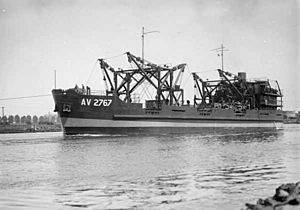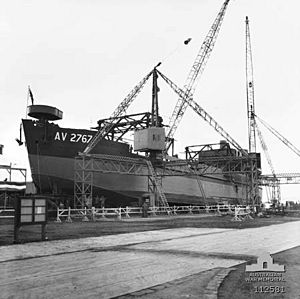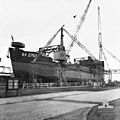Australian Army ship Crusader (AV 2767) facts for kids

Crusader in December 1945
|
|
Quick facts for kids History |
|
|---|---|
| Operator |
|
| Builder | Melbourne Harbour Trust, Williamstown Dockyard |
| Launched | 8 August 1945 |
| Commissioned | Late 1945 |
| Decommissioned | 1947 |
| Out of service | 1984 |
| Renamed |
|
| Fate | Sunk as a dive wreck in 1986 |
| General characteristics | |
| Displacement | 1,500 long tons (1,500 t) |
| Length | 200 ft (61.0 m) |
| Beam | 50 ft (15.2 m) |
| Draft | 12 ft (3.7 m) |
| Ramps | Six vehicle loading ramps |
| Propulsion | Six Ruston & Hornsby engines and six propellers |
| Speed | 9 knots (17 km/h) |
| Endurance | 30 days |
| Capacity | 1,500 long tons (1,500 t) of cargo in three holds and 40 vehicles as deck cargo |
| Complement | 31 |
| Armament | Fitted for self-defence guns at the bow and stern |
| Notes | Characteristics are for the ship's Army service and are from and |
Crusader (AV2767) was a special ship used by the Australian Army during and after World War II. She was designed to help with 'amphibious operations', which means moving troops and equipment from sea to land. Launched in 1945, just before the war ended, Crusader helped bring Australian Army gear back home from islands near New Guinea.
Later, the Army didn't need such a large ship. So, in 1947, she was sold to a company called Queensland Cement and Lime Company. They renamed her Cementco. For many years, she worked as a 'coral barge' on the Brisbane River, carrying coral for making cement. In 1986, the ship was purposely sunk and became a popular spot for scuba divers.
Contents
Building a Unique Ship: Crusader's Design
Towards the end of World War II, the Australian Army needed a better way to move heavy equipment. They had trouble getting large items and small boats from Australia to the battle areas in the South West Pacific.
To solve this, a clever engineer named Major General Clive Steele decided to design and build a new type of ship. He wanted a ship that could support 'amphibious operations'. This meant it could get close to shore and unload supplies easily.
Special Features of the Crusader
Crusader's design was quite unusual.
- She had a shallow bottom, which allowed her to operate in shallow waters near the coast.
- The ship had four rudders and six engines, each driving its own propeller. This made her very easy to steer and move around.
- Even though she needed powerful engines, only smaller ones were available in Australia at the time. Six of these engines were fitted, but the ship was still considered a bit slow for the Army.
- Crusader's cargo hold could carry a huge amount of supplies, about 1,500 tonnes.
- She could also carry 40 vehicles on her deck.
- The ship had six large cranes to lift heavy equipment.
- She also had six special bridge-like ramps. These ramps helped vehicles drive on and off the ship easily.
- All this equipment allowed her to unload cargo very quickly.
- Crusader looked very 'box-like'. Naval engineers thought her design was a bit strange.
Building the Largest Welded Ship
Crusader was built by the Melbourne Harbour Trust at Williamstown Dockyard. She was the biggest ship in Australia at the time to be made entirely from welded steel.
The ship was launched on August 8, 1945, and was named by Major General Steele's wife. She became the largest ship ever commissioned by the Australian Army during World War II. Another ship, called AV2768 Corsair, was also started, but it was cancelled when the war ended.
Crusader's Life at Sea
Serving the Australian Army
Crusader finished her tests in late 1945 and began working for the Army. In 1946, she sailed to places like Rabaul and Torokina near New Guinea. She was very good at her job, bringing supplies and equipment back to Australia from these islands.
She also carried the bodies of 600 Australian soldiers who had died in the Solomon Islands. She took them to Port Moresby for burial in the war cemetery there. Crusader even transported 800 local New Guineans to a special center in Rabaul. Another time, she moved 44 tanks from Torokina to Sydney.
By early 1947, the Army didn't really need a ship like Crusader anymore. So, she was loaned to the Australian Shipping Board. She carried earth-moving equipment from Melbourne to Launceston in Tasmania. Then she brought timber back to Melbourne.
Even though she was on loan, Army crew members still operated her. She made several more trips between Tasmania and the mainland. However, some people thought the ship wasn't safe enough for long-term commercial use. After some discussion, it was decided to sell Crusader. The Queensland Cement and Lime Company (QCL) bought her. She arrived in Brisbane on September 28, 1947, and was renamed Cementco.
Working for the Cement Company
QCL changed Cementco into a self-propelled 'coral barge'. This meant she could move herself while carrying coral. The ship was changed a lot in Brisbane.
- Her wheel-house (where the ship is steered) was moved from the back to closer to the front.
- Her cargo holds were changed to carry up to 2,000 tonnes of coral.
After these changes in 1948, a newspaper said she had become "the strangest vessel on the Australian waterfront." Later, her back section was made longer so that each crew member could have their own room.
In her new job, Cementco carried coral that was dug up from Moreton Bay. She took the coral to QCL's cement factory in Darra, Brisbane. Every three years, Cementco would go into a special dry dock at Cairncross Dockyard for maintenance.
During the big 1974 Brisbane flood, the ship's crew had to tie Cementco to the strong poles of the Story Bridge. This stopped her from being swept away down the Brisbane River by the floodwaters.
Cementco continued to carry coral until the mid-1980s. Then, the company bought a new ship. Cementco was put aside while they tried to sell her. During this time, she was renamed Crusader II to avoid confusion with the new ship. No buyer was found, so in 1986, Cementco was sunk on purpose at Flinders Reef near Cape Moreton. She quickly became a popular spot for scuba divers to explore.
See Also
Images for kids





